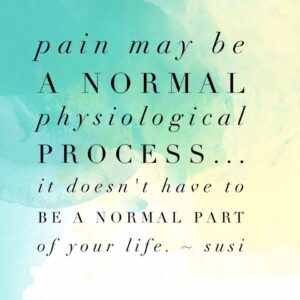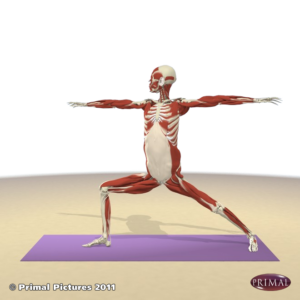By Susi Hately, B.Sc. Kinesiology, C-IAYT Yoga Therapist
Pregnancy. For many women, the delight of finding out that a little one (or more) is growing inside is enough to send them floating a few feet off the ground. Then, the reality of actually growing a baby (or more) begins to settle in. The hormonal changes, cravings, aversions, acute sensitivities . . . they are all quite awe-inspiring in how they influence and respond to the being(s) growing within.
If you have been following me for awhile it won’t be a surprise that I have had and still have such an immense wonder at my own body growing, changing, and shifting; how I respond to the ever changing needs of my physical structure; and how those relate and are impacted by my emotional and mental state.
I’ve had a certain advantage moving into this first pregnancy. Not only do I have my degree in Kinesiology, and experience with yoga and its therapeutic applications, I’ve taught dozens and dozens of pregnant yogis at various stages of wellbeing. Both of my sisters have had multiples (one sister had twins, another had triplets) and I am an identical twin myself. It was only 14 years ago that I witnessed my sisters’ ever expanding journey, and was in the room with my oldest sister during the delivery. There were also the stories from my mom and her friends at how she managed all the way to a full term, 40 week twin pregnancy.
So I entered into this with eyes open, realizing that my small stature would need all the stability, suppleness and strength to support the ever changing dynamics of my physical structure. Now that I am at 20 weeks, half baked as they like to say, this blog post is about sharing a sampling of what I have done to support my structure, enabling me to keep moving well and feeling good.
Napping: I have always liked a good 15-20 minute nap mid afternoon once or twice a week. These days, I am relishing in my naps – they range from 15-30 minutes, and are starting to increase in regularity and frequency. They are a boon to a clearer mind and better function overall.
Breathing: I want to stay as connected to my pelvic floor, belly and diaphragm as long as I can, and I spend a lot of time being aware of and working with full body breathing. I incorporate this awareness into all of what I do. Donna Farhi’s Book The Breathing Book is a great resource.
Rib Cage and Inner Hip Massage: Early on I could tell the babies liked to be left. One in particular likes to hang in the lower left quadrant of my torso (and we saw his head there on our last ultrasound), which can lead to a feeling of tightness. With regular self – massage, I have been able to soften the tissue throughout my torso which has helped the wee boy to shift more right, and for me to be more at ease overall whether sitting, standing or sleeping.
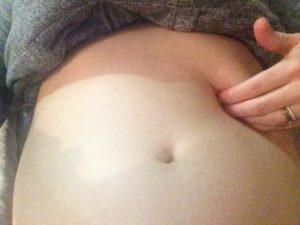
The photo above shows me with my fingers gently under my ribs. The photo below shows my fingers on the inside of my hip bone. If you decide to explore this, be gentle as you use your fingers, and be sure to “let the tissue let you in”. Don’t force and allow your breath to be super easy. Eyes soft, and jaw relaxed.
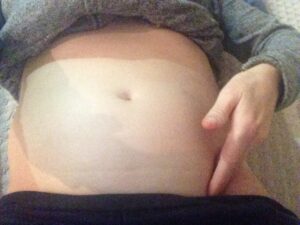
Side Bend over a Rolled Felt Pad: I place the felt pad so that I side bend and my shoulder touches the floor. I then breathe into my side ribs, being mindful of not increasing the volume of breath, rather directing the breath to that area of my rib cage. You may be wondering what this has to do with a stable pelvis. Here is one reason, which I will expand on in a future blog post – with a more supple and less braced rib cage there is less compensation and I manage and absorb the load more efficiently. The muscles around my hips (and everywhere else) are able to do their assigned job). I will share more about the felt pad in next week’s blog post.

“Yoga Wheel” or On the Ball Extension: I find this to be a lovely experience through the torso. In the photo below you will see me on my homemade “Yoga Wheel”. An exercise ball works too. To do this well, and safely, you need to be sure to have enough pelvic stability, hip extension and spinal extension. You also need strength through your glutes. If you feel really tight through the front of your body, it may not be a suitable movement for you. Easy breathing, soft jaw and smooth movement are three important keys here.
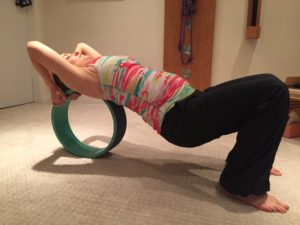

Squat: I will either lower from standing legs wide into a squat without pushing out with my hands, or I will scoot onto a bolster and sit with legs wide. I can access my breath and pelvic floor really nicely here, and also train my glutes to function well (as opposed to pushing my legs back with my arms). Be mindful of your feet – as you set yourself up be sure to feel the following 3 points on the floor – the center of the heel, the ball of the foot and base of the pinky toe.

Regular Yoga, Stability, Mobility, Weight, Cardio Workouts: I attend a weekly group prenatal yoga class that focuses on quite a bit of strength work, and I couple this with my own yoga session along with very specific weight/stability/mobility training and gentle elliptical or walking. I was running up to becoming pregnant and suddenly felt the intuitive need to stop. I switched to cycling, and around week 13 my belly was limiting the movement of my legs – which is why I switched to more walking and elliptical.
These are just a sampling of what I have been working with to help my body absorb the load of my growing babies, belly, and the dynamic shifts that come with that. This will change as I continue to grow and the load of my developing babies grows and shifts.
In March, I will be hosting the Female Core and Pelvic Floor Online Conference with expert speakers who will be discussing the pelvic floor and many of its nuances pre-pregnancy, during pregnancy, post pregnancy and beyond. For details, please visit – https://www.functionalsynergy.com/product/female-core-pelvic-floor-online-conference/
Enjoy,
Susi

